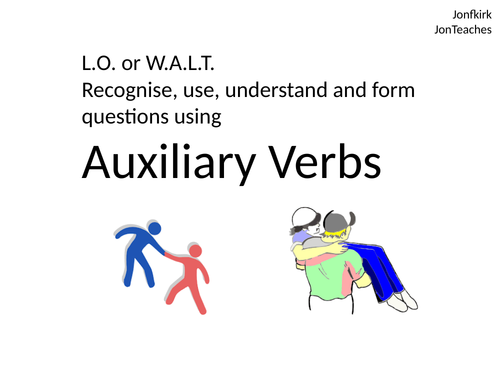




Everything you need to teach AUXILIARY VERBS. Easy to follow and teach with no planning required. Pupils will learn how to create questions, the present continuous and the present perfect using the auxiliary verbs to do, to be and to have. Great preparation for SATS and Cambridge English exams.
Outcomes/ Objectives
UNIT 1
I can identify the subject of a sentence.
I can identify the main verb of a sentence.
I can recognise the present continuous tense and tell you how to form it.
I know that to BE can be used as an auxiliary verb.
I can tell you when the verb to BE is used as an auxiliary verb and why.
UNIT 2
I know that a question must have an auxiliary verb.
I can create a question using the verb to DO.
I know that if a statement does not have an auxiliary verb I must use the verb to DO in my question.
I know that the verb to DO must match the tense of the original statement.
I know that the structure of a sentence is A S M (auxiliary verb, subject, main verb).
UNIT 3
I can recognise a sentence in the present continuous.
I know that the present continuous is formed using the verb to BE and –ing and can write a sentence in the continous present.
I know that I can use the auxiliary verb in a present continuous sentence to form a question.
I know that the words “am, are, is” come from the verb to BE.
I can change a statement in the present continuous to a question without using the verb to DO.
I know and can show that “Is the dog barking loudly?” uses the correct structure for a question.
UNIT 4
I know that I can use the auxiliary verb in a present continuous sentence to form a question.
I know that the words “am, are, is” come from the verb to BE.
I can change a statement in the present continuous to a question without using the verb to DO.
I know and can show that “Is the dog barking loudly?” uses the correct structure for a question.
I know that to DO, to BE and to HAVE can all be used as auxiliary verbs.
I can recognise and use the present perfect.
I can create questions using the verb to HAVE as an auxiliary.
I can identify the structure of a question which uses to HAVE as the auxiliary.
I know that to DO is used to create questions, to BE to create the present continuous and to HAVE to create the present perfect.
I understand that to Do, to Be and to HAVE can also be used as main verbs
Get this resource as part of a bundle and save up to 18%
A bundle is a package of resources grouped together to teach a particular topic, or a series of lessons, in one place.
Something went wrong, please try again later.
This resource hasn't been reviewed yet
To ensure quality for our reviews, only customers who have purchased this resource can review it
Report this resourceto let us know if it violates our terms and conditions.
Our customer service team will review your report and will be in touch.